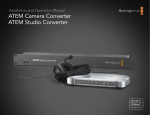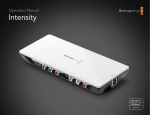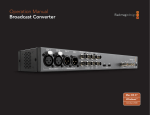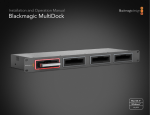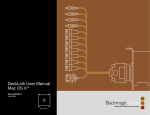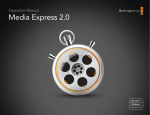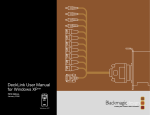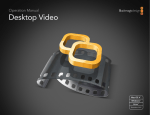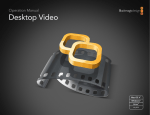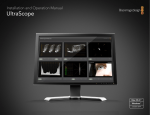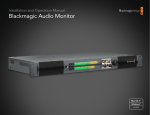Download Blackmagicdesign UltraStudio Pro Instruction manual
Transcript
Operation Manual UltraStudio Pro USB 3.0 Windows™ April 2011 Contents UltraStudio Pro 04 41 How to Install Betacam SP analog deck 42 SDI digital deck 43 Sony HDCAM SR deck in 4:2:244 Composite monitor 45 YUV component monitor 46 Connecting to an HDTV 47 HDMI Workflow48 Installation5 Product Diagram 5 Before Connecting UltraStudio to your USB 3.0 computer6 Connecting UltraStudio Pro 7 Installing Desktop Video software 8 09 Software Blackmagic Software 10 Setting Blackmagic Preferences 10 Blackmagic Media Express18 Blackmagic Disk Speed Test 29 Disk arrays 29 Third Party Applications Adobe Premiere Pro Adobe After Effects Adobe Photoshop Sony Vegas Pro 9 36 30 30 33 34 35 Helpful Information Support 37 USB 3.0 Frequently Asked Questions37 Uncompressed data rates for capture and playback39 Troubleshooting40 Connection Diagrams 49 Warranty Warranty Terms and Conditions 50 3 Welcome Welcome to UltraStudio Pro. We hope you share our dream for the television industry to become a truly creative industry by allowing anyone to have access to the highest quality video. Blackmagic UltraStudio Pro is the first uncompressed editing solution that connects via the new SuperSpeed USB (USB 3.0) found on the latest computers. USB 3.0 is easy and you can just plug in your UltraStudio Pro. Previously high end television and post production required investment in millions of dollars of hardware. However with UltraStudio Pro and USB 3.0, even 10 bit uncompressed high definition TV is now easily affordable. We hope you get years of use from your new UltraStudio Pro and have fun working with some of the world’s hottest television and design software! This instruction manual should contain all the information you’ll need to connect UltraStudio Pro to your computer and video hardware. As UltraStudio Pro uses uncompressed video and the data rates are quite high, you’ll need fast disk storage. We think it should take you approximately 5 minutes to complete installation. Before you connect UltraStudio Pro, please check our website at www.blackmagic-design.com and click the support page to download the latest updates to this manual and UltraStudio Pro driver software. Lastly, please register your UltraStudio Pro when downloading software updates. We would love to keep you updated on new software updates and new features for your UltraStudio Pro. Perhaps you can even send us your latest show reel of work completed on your UltraStudio Pro and any suggestions for improvements to the software. We are constantly working on new features and improvements, so we would love to hear from you! Grant Petty CEO Blackmagic Design 4 How to Install 5 Installation UltraStudio Pro 2. RS-422 Deck Control 2 3. R-Y Out 3 4. Y Out 4 5. B-Y Out 5 6. Ref In 6 7. R-Y In 7 8. Y In 8 9. B-Y In 9 10. AES / EBU Out CH1&2 10 11. AES / EBU In CH1&2 11 12. Analog Audio Out 1 12 13. Analog Audio Out 2 13 14. Analog Audio In 1 14 15. Analog Audio In 2 15 16. Analog Audio In 3 16 17. Analog Audio In 4 17 18. Analog Audio Out 3 or AES/EBU CH3&4 Out 18 19. Analog Audio Out 4 or AES/EBU CH5&6 Out 19 20. Composite In 20 21. Composite Out 21 22. S-Video In 22 23. S-Video Out 23 24. Standard Definition SDI Out 24 HDMI Input HDMI Output 3G/HD/SD-SDI Output USB 3.0 3G/HD/SD-SDI Input Power Breakout cable connector UltraStudio Pro Breakout Cable 6 Installation Before Connecting UltraStudio Pro to your USB 3.0 computer IMPORTANT INFORMATION USB 3.0 hardware requires the latest versions of USB 3.0 software drivers and firmware to enable the high speed performance required for high definition video capture and playback. While most new motherboards and computers are now shipping with suitable versions of USB 3.0 software drivers and firmware, it is very important to ensure you have installed the latest versions before installing your Blackmagic Design USB 3.0 product. Please download the latest USB 3.0 drivers and firmware, for your USB 3.0 motherboard or computer, from the vendor’s website. 7 Installation Connecting UltraStudio Pro 1. Connect the included power supply to UltraStudio Pro. Switch on the power. 2. Use the included SuperSpeed USB 3.0 cable to connect UltraStudio Pro directly to a dedicated USB 3.0 port on your computer. 3. If UltraStudio Pro software has previously been installed and offers to update the firmware, click Update to run the update. When the firmware update is finished, the onscreen instructions will prompt you to power the UltraStudio Pro off and on. UltraStudio Pro is now ready for use. The professional breakout cable can be connected to UltraStudio Pro at any time using the multi-pin connector. The connection diagrams toward the end of this manual show how to connect UltraStudio Pro to many kinds of video equipment. Connect the included SuperSpeed USB 3.0 cable to UltraStudio Pro and to your computer. Connect the professional breakout cable to UltraStudio Pro. 8 Installation Installing Desktop Video software Contents The Desktop Video software installer will install the following components: Desktop Video Setup Wizard Blackmagic Desktop Video drivers Blackmagic Design Control Panel Blackmagic Media Express application Blackmagic AVI and QuickTime™ codecs Blackmagic Disk Speed Test Adobe® presets and plug-ins Desktop Video software 1. The CD supplied with UltraStudio Pro contains the Desktop Video software. Before you install, ensure you have the very latest driver. Visit www.blackmagic-design.com/support 2. Open the “Desktop Video” folder and launch the “Desktop Video” application. 3. The drivers will now be installed on your system. An alert will appear: “Do you want to allow the following program from an unknown publisher to make changes to this computer?” Click Yes to continue. Click “Yes”. 4. You will see a dialog bubble saying “found new hardware” and the hardware wizard will appear. Select “install automatically” and the system will find the required Desktop Video drivers. You will then receive another dialog bubble saying “your new hardware is ready for use.” 5. Now restart your machine to enable the new software drivers. Automatic firmware updating After your computer has restarted, the software will check the UltraStudio Pro hardware to see what firmware the card contains. If the firmware version does not match the software version, Desktop Video will offer to update the firmware. This is automatic and all you need to do is click OK to start the update. After the firmware has updated, restart your computer to complete the process. Programmable firmware can provide new features, compatibility with new hardware and support for new formats. Restart your PC! 9 Software 10 Blackmagic Software Setting Blackmagic Preferences UltraStudio Pro preferences are located in the Blackmagic Design Control Panel. The Blackmagic Design Control Panel is used with all UltraStudio Pro, DeckLink, Multibridge and Intensity hardware. Any preferences which are not applicable to UltraStudio Pro will be grayed out and unavailable. The following preferences contain options for setting up your UltraStudio Pro. Settings Blackmagic Design Control Panel. Input and Output connections NTSC Setup 1080p/1080PsF switch Remove Field Jitter Output black/last played frame switch Reference Output Timing (Genlock) Processing Output processing Input processing VITC Reader A Frame - 3:2 Pulldown Removal VANC input Video Levels Blackmagic Design Control Panel Calibrate Analog Video In Calibrate Analog Video Out Betacam/SMPTE level switch Audio Levels HiFi/Professional Audio Levels Analog Audio Input Levels Analog Audio Output Levels AES/EBU Input Reference Level AES/EBU Output Reference Level 11 Blackmagic Software Setting Blackmagic Preferences UltraStudio Pro video and audio output connections Video and Audio Output Connections All of the video and audio outputs of UltraStudio Pro are active all of the time and the only choice you need to make is between 4 analog and 2 AES/EBU audio channels, or 2 analog and 6 AES/EBU audio channels, as they use shared connectors. The SDI, HDMI and component (Y,R-Y,B-Y) analog video outputs support HD and SD video. S-Video and composite analog video do not support high definition video but UltraStudio Pro always lets you see downconverted SD video on these outputs when working with HD video! UltraStudio Pro switchable audio outputs UltraStudio Pro has switchable audio outputs. You can choose to output: 4 analog and 2 AES/EBU audio channels, or 2 analog and 6 AES/EBU audio channels UltraStudio Pro video and audio input connections Your UltraStudio Pro supports all of the following combinations: Video and Audio Input Connections SDI Video & SDI Audio SDI Video & AES/EBU Audio SDI Video & Analog XLR Audio HDMI Video & HDMI Audio HDMI Video & AES/EBU Audio HDMI Video & Analog XLR Audio Component Video & AES/EBU Audio Component Video & Analog XLR Audio Composite & AES/EBU Audio Composite & Analog XLR Audio S-Video & AES/EBU Audio S-Video & Analog XLR Audio 12 Blackmagic Software Setting Blackmagic Preferences NTSC setup NTSC Setup The NTSC composite video used in the USA, and some other countries uses 7.5% setup. However setup is only used in composite video, but is never used in SDI video. Your UltraStudio Pro will handle adding and removing setup from NTSC video automatically for you. The USA and countries that use 7.5% setup should enable this setting; if you’re working in Japan and countries that don’t use this setup, leave this set to 0 IRE setup. The PAL and high definition standards do not use this setup. Progressive HD1080 video By default, progressive HD1080 video frame rates are treated as progressive segmented frame, i.e. 23.98PsF, 24PsF and 25PsF. If you enable Use 1080p not 1080PsF progressive HD1080 video frame rates will be treated as true progressive, i.e. 23.98p, 24p and 25p. 1080p/1080PsF switch Remove Field Jitter “Remove field jitter when video is paused” allows UltraStudio Pro to display only a single field when paused, while turning this mode off will display a complete frame in pause. Single field is similar to how Betacam SP decks work when paused, eliminating field flicker from paused images. If you’re doing work without interlaced video, such as animation, then you can turn this mode off so you can see both fields in full resolution for best quality. Regardless of this setting, you always get the correct full frame dual field output when in playback mode, as this setting only effects paused video. Video Output Behavior 13 Blackmagic Software Setting Blackmagic Preferences Output black/last played frame switch If you have switched out of a video application and so video is not being played, this setting determines whether UltraStudio Pro will output black or the last played frame of video. Output black/last played frame switch Reference Output Timing Genlock, also known as black burst, reference or house sync is used to lock various equipment in your facility to the same timing point. When two or more video devices are connected to the same sync signal, their video signals can be switched without jumping or rolling. This is critical when connecting equipment in large post production facilities and broadcast stations. To change video to reference timing: Reference Output Timing Adjust the Set reference output timing for timed output until the picture locks and is no longer rolling on the display. 14 Blackmagic Software Setting Blackmagic Preferences HDTV Down/Up/Cross Conversion UltraStudio Pro includes a powerful image processor which can down-convert high definition to NTSC or PAL video in real time. It can also upconvert from standard definition to 720HD or 1080HD or even cross-convert between 720HD and 1080HD. Select the desired option from the output or input processing menus under the Processing tab. Output Processing Permanent Down Conversion provides both high definition video and down-converted standard definition video output. Choose between letterbox, anamorphic and center cut SD video. SD Letterbox SD Anamorphic SD Center Cut HDTV Up/Down Converter output processing Note: Simultaneous down conversion introduces a 2 frame delay on the SD-SDI output. To ensure accuracy, adjust the playback/timecode offset options when performing an insert or assemble edit to tape with Premiere Pro or Blackmagic Media Express. Analog video outputs are also down converted so you can always see video on an S-Video or composite analog monitor. The HD-SDI, HDMI and Component analog video outputs can be switched between HD or SD video. Choose to Down Convert All Outputs, if you wish to view downconverted SD video on all outputs. Up Conversion from SD to HD 720p provides up-converted HD 720p video output from NTSC and PAL video files. Choose between pillarbox and zoom HD 720p video. SD to 720p HD 4:3 Pillarbox SD to 720p HD 16:9 Zoom Up Conversion from SD to HD 1080i provides up-converted HD 1080i video output from NTSC and PAL video files. Choose between pillarbox and zoom HD 1080i video. SD to 1080i HD 4:3 Pillarbox SD to 1080i HD 16:9 Zoom HD Cross Conversion converts HD 720p to HD 1080i, or HD 1080i to HD 720p. Cross Converted HD 15 Blackmagic Software Setting Blackmagic Preferences Output HD 23.98PsF at HD 59.94i 23.98 fps is a common film frame rate but support for this frame rate in SDI and analog monitors is rare. Enabling this option will apply 3:2 pulldown processing so that HD 23.98 PsF video is output as HD 59.94i. Almost all HD monitors support HD 59.94i. Output HD 23.98PsF at HD 59.94i Input Processing Down Conversion from HD to SD on input makes it possible to capture high definition video to standard definition files. Choose between letterbox and anamorphic SD video. 1080i HD to SD Letterbox 16:9 1080i HD to SD Anamorphic 16:9 720p HD to SD Letterbox 16:9 720p HD to SD Anamorphic 16:9 Up Conversion from SD to HD on input makes it possible to capture standard definition video to HD 1080i files. Choose between letterbox and anamorphic SD video. SD Letterbox 16:9 to 1080i SD Anamorphic 16:9 to 1080i HDTV Up/Down Converter input processing 16 Blackmagic Software Setting Blackmagic Preferences VITC Reader A Frame - 3:2 Pulldown Removal Set A-frame VITC reference (to) Frame ## in 23.98 fps capture from NTSC using 3:2 pulldown Set the A-Frame VITC Reference when performing 3:2 pulldown This option decodes the VITC and uses it to correctly locate the A-frame when performing 3:2 pulldown while capturing video at 23.98fps. Carefully set the correct A-frame VITC reference to match the timecode on tape. Selecting the wrong A-frame will generate incorrect presentation of fields and frames. Preserving Blanking Data or VANC This feature lets you use up to 3 video lines at the top of a captured movie file to store any 3 lines from vertical blanking. This allows 3 line timecode, VITC (vertical interval test signals) subtitle info or any other VANC data to be preserved during capture. These lines are then inserted back into the video blanking when the file is played back. VANC preferences To preserve VANC data: 1. Open the Blackmagic Design Control Panel. 2. Select the VANC and 3:2 Pulldown tab and tick the On check box for video line 1, 2 or 3 depending on how many blanking lines you want to capture. Note: Video file line 1 needs to be enabled for lines 2 and 3 to work. Because these lines can be passed to the application, a developer could write software to read the VANC data and use it for various purposes, e.g. 3-line timecode and audio chasing, or other uses. An example of VANC data is 3-line timecode, which uses lines 18, 19, and 20 in NTSC or lines 19, 20 and 21 in PAL. 3-line timecode, as used in AATON™ equipped telecine suites, featuring audio timecode and keycode information along with the normal timecode numbers. 17 Blackmagic Software Setting Blackmagic Preferences Video Levels A video processing amplifier (Video Proc Amp) is provided for use with analog video and chroma levels and ideally should always be used in conjunction with a waveform monitor. By contrast to digital video, analog video can suffer from inconsistencies even between identical analog devices such as two analog tape decks. The video level controls can be used to correct inconsistencies in analog video input and output. The option to Calibrate Analog Video In will only be available if the Set Input option in the Settings are set to an analog video option. If a digital input is being used, such as SDI or HDMI, or if your Blackmagic capture device does not include analog input, the option to Calibrate Analog Video In will remain grayed out and unavailable. The Reset Gain button resets the video levels back to their original settings. Video levels By default, Blackmagic products use SMPTE component analog levels as almost all analog video monitors and modern video equipment use SMPTE levels. Sony Betacam SP decks can use Betacam levels and you may need to enable the checkbox Use Betacam YUV Levels with these analog decks. Sony CRT monitors support Betacam and SMPTE levels to allow direct monitoring from a Betacam SP deck. These monitors include a switch so you can choose between Betacam and SMPTE and you also need to choose the corresponding SMPTE/Betacam setting in the Blackmagic Video Levels. If in doubt, try a test capture and you should see a very noticeable brightness shift if you choose the wrong levels. Audio Levels An audio processing amplifier (Audio Proc Amp) is provided for use with analog audio. It can be used to raise or lower an audio signal. By contrast to digital audio, analog audio can suffer from inconsistencies between audio channels and so analog audio channels can be adjusted independently from each other. AES/EBU audio is digital and does not suffer from level inconsistencies between audio channels. Accordingly all AES/ EBU audio channels are raised or lowered together. The Reset Gain button resets the audio levels back to their original settings. Professional analog audio levels and XLR audio connectors are standard on UltraStudio Pro, DeckLink and Multibridge products. If you need to connect to consumer audio equipment with analog RCA inputs, enable the option to Use HiFi Audio Levels and use an inexpensive XLR to RCA adapter for each audio connection. Audio levels 18 Blackmagic Welcome Media Express Welcome to Media Express 2.0. Blackmagic Media Express 2.0 is a sophisticated software application which enables UltraStudio, DeckLink, Multibridge and Intensity users to capture, play back and preview video and audio via Blackmagic capture hardware. DeckLink, Multibridge and UltraStudio users can also master to tape, using insert or assemble edit, with frame accurate RS-422 device control. Media Express has an intuitive interface and requires a 1920 x 1200, or 1280 x 800, pixel computer display to compliment its uncluttered appearance. The capture, playback and master views are color-coded so you will know at a glance which mode is being used. Media Express uses many of the same keyboard shortcuts which are standard in the video industry so there is little to learn. Use j, k, l to shuttle backwards, pause and shuttle forwards, or use i and o to mark in and out points when batch capturing or mastering to tape. Hold down the control and shift keys to reveal a jog wheel and then use your mouse, with the jog wheel, for precision control of your tape deck. VITC timecode is supported via RS-422 and RP188 timecode is supported via SDI. DeckLink, Multibridge and UltraStudio users can use the Media List feature to log multiple clips for batch capture or to seamlessly play back multiple clips from a playlist and master them to tape. Media Express can directly capture to, and play back from, DPX files or movie files. Use the Grab Frame feature to capture still images during capture, playback or when mastering to tape. Frame grabs are saved in the targa (.tga) graphic file format. Blackmagic Media Express 2.0 is not NLE software and does not have a timeline. It is a great tool when you don’t need the complexity of NLE software but simply want to capture, play back and output clips to tape, especially when working with video compositing software. 19 Blackmagic Welcome Media Express Blackmagic Media Express 2.0 Interface Media List Search field Remote indicator VTR / deck timecode Video Preview Transport Control Mark In / Mark Out Track enable/disable Project name, video format and frame rate 20 Blackmagic Welcome Media Express – Preferences Media Express preferences are accessed from Edit>Preferences. Project Video Format Project Video Format defines the frame rate and frame size of the current project. The formats displayed are those supported by your UltraStudio Pro and you may see some differences when compared to running Media Express with DeckLink, Multibridge, UltraStudio or Intensity. Capture File Format Capture File Format sets the video codec and file format when capturing in the current project. On Windows, the capture file format options are either AVI movies or DPX files. A choice of Blackmagic Uncompressed or Motion JPEG codecs can be made when capturing to AVI movies. Preferences Video formats Capture file formats 21 Blackmagic Welcome Media Express – Media Preferences List The Media List holds a list of clips used in a project. When in Capture view, the Media List can be a list of clips to be batch-captured. Media List becomes a playlist when used in Playback or Master view. These views are explained later in the manual. The Media List can contain clips that are of different codecs as long as they are of the same frame rate and size. The Media List is a project which can contain clips of the same frame size and frame rate. The list can be sorted by each column heading. Columns can be rearranged and widened if desired. The order of the clips in the list can be sorted manually by dragging and dropping within the list. Single or multiple clips can be dragged and dropped together. The film strip icon on the left of the list shows whether a clip has linked media. If a clip has no linked media, the film strip icon displays a red “X” and selecting the clip will show a “Media Offline” message in the Video Preview Window. Clips can be added to the list by: double-clicking on an empty area in the list selecting File > Import > Media Files right-clicking on the list and selecting ‘Import Media Files’ capturing a clip from tape. Right-clicking in the Media List will open a contextual menu. Depending upon the menu item chosen, Media Express will switch to the appropriate Capture, Playback or Master view that fits the operation. For example, right-clicking on a clip, and selecting “Batch Capture” while in Playback view, will cause Media Express to switch to Capture view and carry out the batch capture operation. Media Express can play back files of different codecs, in the same playlist, as long as they are of the same frame rate and size. For example, you may have a mix of 1080p23.98 MJPEG and 1080p23.98 Uncompressed video clips in the same playlist and Media Express will play them out seamlessly. Media List showing an untitled clip which is not linked to any media. Right-clicking on the missing media icon will reveal a contextual menu from where Batch Capture can be selected. 22 Blackmagic Welcome Media Express – Capture Preferences Media List Capture View showing the contextual menu, in the Media List, can be used to start a Batch Capture. This performs the same function as clicking the Get Clip button. 23 Blackmagic Welcome Media Express – Capture Preferences Media List Capture operations are performed in the Capture view (ctrl-1) Capturing on the fly. Ensure the Project Video Format is set to the format of video you wish to capture. Ensure the Capture File Format is set to the format you wish to capture. Connect a video source to an input of your UltraStudio Pro. Ensure the desired input has been selected in the Blackmagic Design Control Panel. If deck control is required, ensure an RS-422 serial cable is connected and “remote” has been selected on the deck. If an RS-422 cable is not connected, or “remote” is not selected on the deck, the transport controls will be grayed out and “No Remote” will be displayed in the top right corner of the Video Preview Window. Enter Reel and Name information into the information area. The Name will be applied to the clip(s) which are about to be captured. Before capturing, the audio channels to be captured can be switched on or off via the track enable/disable buttons. The video track cannot be turned off. Click on the “Capture” button to commence capturing. To end capture, click on the “Capture” button again or press the “Esc” key. Logging Clips for future batch capture. Click the Mark In button to mark the In point, or use the shortcut key i. Click the Mark Out button to mark the Out point, or use the shortcut key o. Click the Log Clip button to log the clip, or use the shortcut key p. The entry should now appear in the Media List window. Continue logging other clips. When logging is completed, select the clips in the Media List and either: Click on the ‘Get Clip(s)’ button. Right-click on the selection and select ‘Batch Capture’. 24 Blackmagic Welcome Media Express – Capture Preferences Media List Capturing a clip with precise In and Out timecode. Click on the Mark In button to mark the In point or use the shortcut key i. Click on the Mark Out button to mark the Out point or use the shortcut key o. Click on the Get Clip button. Media Express will cue the tape and precisely capture the clip from the In to the Out timecode points, including any handles specified in the application preferences. While capturing, if the file name (Name) of a clip already exists on the selected capture drive, the user will be prompted if they want to over-write the file or not. If ‘No’ is selected, the file name will be auto-incremented with a number. 25 Blackmagic Welcome Media Express – Playback Capture Preferences Media Capture List Playback View 26 Blackmagic Welcome Media Express – Playback Capture Preferences Media Capture List Playback operations are performed in the Playback tab (ctrl-2) Importing clips into the Media List Import media into the Media List using one of the following methods: Double-click on an empty area of the list. Select File > Import > Media Files. Right-click on the list and select ‘Import Media Files’. Capture a clip from tape. Any of these actions will reveal an Open Video Clip window where more where one or more files can be selected. If the files being imported match the frame rate and size of those in the Media List, the import will be successful. If the files being imported do not match the frame rate and size of existing clips in the Media List, the user will be prompted to create a new project and to save the current project. If the current project has had no changes, and has already been saved, the user will only be prompted to start a new project as there is no need to save the existing project. Playing back a single clip Selecting a clip (single click) on the list will load it into the Video Preview Window. To play back a single clip in the Media List, double click the clip and it will start playing in the Video Preview Window. To loop the playback of the clip, click on the loop button in the transport control. The selected clip will now play back and loop until the user clicks on the pause button or presses the spacebar. Playing back multiple clips To play back multiple clips, select the clips in the Media Library and click the Play button or press the spacebar. Selected clips in the playlist will be played back in sequence. Unselected clips will not be played. If no clips are selected, the whole playlist is played back, starting from the last-played clip. Clicking on the loop button will cause the playback to loop. During playback, the audio channels being monitored can be switched on or off via the track enable/disable buttons. The video track cannot be turned off. 27 Blackmagic Welcome Media Express – Master Capture Playback Preferences Media Capture List Master View 28 Blackmagic Welcome Media Express – Master Capture Playback Preferences Media Capture List Mastering to tape operations are performed in the Master view (ctrl-3) Media Express can use UltraStudio Pro to master to tape via Insert or Assemble editing. Only clips that are selected in the Media List will be output to tape. If no clips are selected, it is assumed that the entire Media List will be output. To master to tape, click on the Master view and ensure RS-422 device control is connected. Enter the In and Out points of the tape by entering timecode into the respective text boxes, or by cueing the tape to the desired point via the transport control and then clicking the Mark In button, or use the shortcut key i. If no Out point is entered, Media Express will set the duration of the edit to the total length of the clips in the Media List. If an out point is defined, Media Express will leave edit mode once the Out point timecode is reached, even if some clips have not been output. The Insert and Assemble buttons are mutually exclusive and only one mode can be selected at a time. This determines which mode Media Express will use to master to tape. Select the Insert or Assemble button as required. The Preview and Master buttons are also mutually exclusive. Clicking on either button will instruct Media Express to proceed with the specified operation. Preview mode mimics the edit process but does not record to tape. This mode allows one to check the edit point is correct. Preview edit operations should always be checked on monitors connected directly to the output of the deck to view the preceding video already on tape, the new video and the following video already on tape. If Record Inhibit is enabled either on the deck or on the tape in the deck, Media Express will display a dialog box, when the user clicks on the Master button, informing the user that Record Inhibit is enabled. Check the deck/tape and disable Record Inhibit before trying again. Before mastering, the audio channels to be put to tape can be selected on or off via the track enable/disable buttons. The Video track cannot be turned off. 29 Disk Storage Blackmagic Disk Speed Test If you want to check your disk array speed, Blackmagic Disk Speed Test can be run to check the array speed, and to provide the results in video frame rates. This makes it much easier to understand how various disk arrays will handle video capture and playback at various video resolutions and frame rates. Disk Speed Test provides more accurate results for large disk arrays, as often the manufacturer provided speed results only check small data blocks; so you only get an indication of the cache speed of the disk and not the sustained data rate of the disk. Video uses sustained data rates and only Disk Speed Test provides a long burst of data for more accurate results. Please see the separate Disk Speed Test Manual for detailed information about using Blackmagic Disk Speed Test. The manual is a PDF file and can be found on the installation CD or in the downloaded software package for your capture hardware. Blackmagic Disk Speed Test. Disk arrays If you intend to run your disk array as a software stripe, you will need to make sure that ‘host RAID’ is disabled. Use the “Disk Management” tool in “Computer Management” within Windows™ to set up your software RAID, or refer to third party instructions when using pre-configured hardware RAIDs. Further information can be obtained via the Windows™ Help and Support. Search and review the section on “Dynamic Disks”. This section will provide you with information on how to convert a basic disk to dynamic disk and configuration steps on striping your disk array. Disk Management 30 Third Party Applications Adobe Premiere Pro CS5 Adobe Premiere Pro® is a powerful real-time video and audio non-linear editing application. Full presets for Premiere Pro are included with the Blackmagic driver software and will be automatically loaded into your system during the installation process. Premiere Pro must be installed on your system before running the Desktop Video installer. Adobe Premiere Pro Premiere Pro can capture and playback with sequences of different formats within the one project. For example, UltraStudio Pro can capture 1080i59.94, 1080i50 and NTSC video to corresponding sequences within the one Premiere Pro project. Setting Up 1. Launch Premiere Pro CS5. 2. Create a New Project and set the Capture Format to Blackmagic Capture. 3. Click on the Properties button and then choose from the desired properties for your project. The Video Standard can be set to NTSC, PAL, HD720, HD1080 or 2K. The Video Format can be uncompressed or compressed and you should also specify the number of audio channels to be captured. Now click OK. 4. Select your disk array as the Location for your media. 5. Set the location and type the name of your project. Click OK. New Sequence 6. The New Sequence window will appear. Select the desired Blackmagic preset, give the sequence a name and then click OK. Audio Blackmagic software features support for multiple channels of audio in Premiere Pro CS5 using the Blackmagic audio plugin. Blackmagic audio hardware is automatically chosen when a new project is created and the capture format is set to Blackmagic Capture. The choice of audio hardware can also be configured through Edit > Preferences > Audio Hardware. The ASIO Settings button serves no function as ASIO audio is not used for capture or playback. Audio Output Mapping You may also wish to visit Edit > Preferences > Audio Output Mapping to select the mix of the multi-channel audio. Set Map Output for to either Blackmagic Audio or Blackmagic Audio (CS5) as both are the same as each other. 31 Third Party Applications Device Control UltraStudio Pro includes RS-422 device control for connection to decks. Blackmagic Device Control is automatically chosen when a new project is created and the capture format is set to Blackmagic Capture. The choice of device control can also be configured through Edit > Preferences > Device Control. Device Control The Options button is disabled as the settings are automatically detected and configured when you choose Blackmagic Device Control. Player Settings The default player should be switched from Adobe Player to Blackmagic Design Playback. The choice of player settings can be configured through Edit > Preferences > Player Settings. Playback As a quick test to make sure everything is connected correctly, use the Premiere Pro test media (Bars and Tone or Universal Counter Leader). Drag your test media from within the Premiere Pro project and drop it on to the timeline. You should now see the image on both your computer desktop and the output of your UltraStudio Pro. If you can’t see any video on your Blackmagic output, check the connections again and ensure you have the correct output settings configured in the Blackmagic Design Control Panel. SDI, HDMI and analog outputs are always active. Capture To capture choose: File > Capture [F5] To immediately capture, click the red record button [G]. If you wish to log the clip, enter the desired In and Out points using either the Set In and Set Out buttons, or manually by typing the timecode and clicking Log Clip. The empty clip will now appear in the Project window. Repeat this until you have logged all of the clips you wish to batch capture. To change the capture format, click on the Settings tab and then the Edit button. Ensure the Capture Format is set to Blackmagic Capture, click on the Properties button and then change the Blackmagic Capture Settings as desired. Capture 32 Third Party Applications Batch Capture Select the clips you wish to capture by drag selecting or shift-clicking each clip. Then choose: File > Batch Capture [F6]. To set handles on the clips, enable the option to Capture with handles and type the number of additional frames you require at the start and end of each clip. Export to Tape To export to tape, select the sequence you require and then choose File > Export > Tape Insert editing requires unbroken timecode over the full length of the project which is to be laid to tape. The process of creating unbroken timecode is referred to as “blacking the tape”. In assemble mode the tape needs only to be “blacked” until a point just beyond the start time of the project. As assemble editing erases the tape ahead of the record heads, it should not be used where other projects already exist on the tape after the out point of your edit. When editing to tape, the software waits at the first frame of your project for the deck to drop into record at the predetermined timecode. At that exact moment, the software begins to play until the edit is completed. Should you find that either the first frame of your program is repeated or lost, during the edit to tape procedure, you will need to adjust the playback offset to bring the deck and computer in sync. You should only need to do this once with any combination of deck and computer and the correct setting will be retained. Now, simply enter the desired in point and offsets if required, and click OK. Export to Tape 33 Third Party Applications Adobe After Effects CS5 It’s very easy to setup playback and rendering in Adobe After Effects® for a complete broadcast and design workstation that connects direct to decks for capture and playback of clips. UltraStudio Pro also supports real time preview while working on your compositions. Create a New Composition Launching Adobe After Effects Go to the “Composition” menu and select Composition > New Composition (Control + n) In the dialogue box, select the desired television standard from the pulldown menu. Click OK How to use UltraStudio Pro as a Preview Output Frame Buffer To allow your Adobe After Effects composition to be displayed in real-time through your UltraStudio Pro, go to Edit > Preferences > Video Preview. Select Blackmagic Video Output and the appropriate Output Mode. This lets you view your Adobe After Effects compositions in the correct video colorspace on your broadcast monitor as you work. You will always see the correct color and interlace when working, and you don’t have to wait until your composition is rendered to see what it looks like when output as video. Rendering “Composition Settings” options When you have completed your composition, you will need to render to a pixel format supported by UltraStudio Pro. Following is a list of some supported codecs: AVI codecs Blackmagic 10 bit 4:4:4 (RGB) Blackmagic 10 bit 4:2:2 Blackmagic HD 8 bit 4:2:2 Blackmagic SD 8 bit 4:2:2 Blackmagic 8 bit MJPEG Adobe DVCPRO HD Adobe DVCPRO50 “Video Preview” preferences QuickTime codecs Blackmagic RGB 10 bit (4:4:4) Blackmagic 10 bit Blackmagic 8 bit Blackmagic 8 bit (2Vuy) Apple Photo-JPEG Apple DV - NTSC Apple DV - PAL 34 Third Party Applications Adobe Photoshop CS5 UltraStudio Pro includes Adobe Photoshop® plug-ins, so you can directly capture and output still frames from within the Photoshop application itself. If you’re working with 10 bit HD/SD-SDI, you can even import and export 16 bit Photoshop images for full quality. Use UltraStudio Pro keying to export and key graphics from the video input using Photoshop alpha channels. Launching Adobe Photoshop Import an image into Photoshop 1. From Photoshop select File > Import > Blackmagic Image Capture 2. Select the “Video Input Format” and the “Image Bit Depth” and then click Capture Image. Export an image from Photoshop 1.Select File > Export > Blackmagic Image Export 2.Select Video Output Format and then Output Image. Image Capture Image Export Note: Once you have set the options in the “Export” window, each subsequent Export will not display the window so you can output frames much faster. However, if you would like to change your export formats, hold the Ctrl key when selecting export. 35 Third Party Applications / Windows Sony Vegas Pro 9 Sony Vegas Pro 9 is a popular real-time video and audio non-linear editing application that includes uncompressed SD and HD support with UltraStudio Pro. Sony’s included support for Blackmagic Design means that when the Blackmagic Design driver is installed, Vegas Pro 9 will capture and play back video with UltraStudio Pro. Vegas Pro 9 must be installed on your system before running the Desktop Video installer. Launching Sony Vegas Pro 9 Sony Vegas Pro 9 can capture and playback with sequences of different formats within the one project. For example, UltraStudio Pro can capture 1080i59.94, 1080i50 and NTSC video to corresponding sequences within the one Vegas Pro 9 project. Setting Up 1. Launch Vegas Pro 9 2. Create a New Project. 3. In the New Project or the Project Properties windows, choose the desired video and audio properties for your project. 4. The Template can be set to NTSC, PAL, HD720 or HD1080. Capture Video options 5. Select your disk array as the location for your media under Prerendered Files Folder in the New Project or Project Properties windows. 6. To select video capture quality and format, go to Capture Video and select DV, or for broadcast quality uncompressed video, select HDV or SDI. Important Note: Sony Vegas uses the HDV or SDI option for capturing uncompressed video from both SDI, HDMI and analog video connections on UltraStudio Pro. 7. For video capture, go to the Prefs tab, select Capture Prefs and device Blackmagic Design DeckLink and then chose the desired video format and frame rate. Audio Settings Under the Audio tab found in the New Project or the Project Properties windows, you can select your desired audio options and settings. New Project window 36 Helpful Information 37 Support USB 3.0 Frequently Asked Questions Can I use UltraStudio Pro on my Mac? No, currently Macintosh computers do not have USB 3.0 ports. We hope this will change soon. Can I use UltraStudio Pro on my Linux PC? No, currently there is no isochronous USB 3.0 driver support for Linux. We hope this will change soon. Can I use a third party USB 3.0 PCIe card, in my Mac, with UltraStudio Pro? No, currently there is not a suitable USB 3.0 PCIe card that is appropriate for use with UltraStudio Pro. We are working with third parties and soon hope to recommend a card with isochronous USB 3.0 driver support. Can I use a third party USB 3.0 PCIe card, in my Windows PC, with UltraStudio Pro? Yes. Can I use a third party USB 3.0 ExpressCard, in my Mac or Windows notebook, with UltraStudio Pro? No, currently there is not a USB 3.0 ExpressCard with adequate bandwidth for use with UltraStudio Pro. What happens if I plug UltraStudio Pro into a USB 2.0 slot? UltraStudio Pro will not function as USB 2.0 does not provide enough bandwidth for uncompressed video. A USB 3.0 port is required. What motherboards can I use with UltraStudio Pro? Please refer to the Blackmagic Design website: http://www.blackmagic-design.com/support/detail.asp?techID=201 for the latest support information, including supported motherboards with USB 3.0. Which notebooks can I use with UltraStudio Pro? There are currently no notebooks suitable for use with UltraStudio Pro. 38 Support USB 3.0 Frequently Asked Questions Does the DeckLink SDK support UltraStudio Pro? Yes. There are no code changes required by developers to support UltraStudio Pro. The Blackmagic SDK is available as a separate download http://www.blackmagic-design.com/support/software/ Do I need to update my USB 3.0 drivers and firmware to use UltraStudio Pro? Yes, it is essential to run the latest USB 3.0 drivers and firmware for your USB 3.0 equipped motherboard. Please see the section named “Before connecting UltraStudio Pro to your USB 3.0 computer” in this manual for how to check and update the firmware and drivers on your computer. 39 Support Uncompressed data rates for capture and playback The data rates for uncompressed video are quite high, and listed below are minimum recommended disk requirements for uncompressed standard definition and high definition video. Uncompressed 10 bit YUV (4:2:2) Standard Definition Frame Size MB per second MB per minute GB per hour 720x486/29.97fps 27 1 600 94 720x576/25fps 26 1 582 93 1280x720p/60fps 141 8 438 494 1920x1080/24PsF 127 7 594 445 1920x1080/50i 132 7 910 463 1920x1080/60i 158 9 482 556 1280x720p/60fps 211 12 656 742 1920x1080/24PsF 190 11 391 667 1920x1080/50i 198 11 865 695 1920x1080/60i 237 14 238 834 High Definition Uncompressed 10 bit RGB (4:4:4) High Definition Due to disk seeks, when calculating the data rates required for your disk system, it is a good idea to add a safety margin due to fluctuations in disk speed. Disk speeds can be increased by adding more disks. Serial ATA (SATA) disks can reduce to half their speed as they become full, so in a 2-disk SATA array you should aim for a 100% safety margin. In an 8-disk SATA array, a 30% safety margin should be adequate. SCSI disk arrays seem to display less fluctuation and so a 20% safety margin should be adequate for an 8-disk SCSI array. Generally the more disks in the array, the better. Note: Although other vendors and third parties may provide different data rates for uncompressed video, the above recommendations are tested for use with UltraStudio Pro. 40 Support Troubleshooting Using your UltraStudio Pro as a capture and playback solution when connected to a computer is exciting, but also complex due to the huge range of different software applications. Video data rates are also very high, so the disk array you use for video storage can have a big impact on your system’s performance. Information about a wide range of disk array solutions and compatible application software would be outside the scope of this manual, however there are four ways to get more information. There are four steps to getting help. 1. Check out the Blackmagic Design website www.blackmagic-design.com/support for the latest support information. We have a huge number of technical notes covering all the common questions we are asked. 2. Call your reseller. Your reseller will have the latest technical updates from Blackmagic Design and should be able to give you immediate assistance. We also recommend you check out the support options your dealer offers as they can arrange various support plans based on your workflow requirements. Your reseller will also understand your disk array configuration, and as disk array problems account for around 90% of support questions with NLE systems, your reseller or disk array vendor will be able to provide expert help. 3. The next option is to email us with your questions using the web form at www.blackmagic-design.com/support/contact 4. Phone a Blackmagic Design support office. Please check our web site for current support phone numbers in your area. www.blackmagic-design.com/company/. Note: Please provide us with as much information as possible regarding your technical problem and system specifications so that we may try to reproduce your problem quickly. Also please let us know how to reproduce any problem you’re having, so we can try it on our test systems before replying to your email. 41 Connection Diagrams 42 Connection Diagrams Connecting to a Betacam SP analog deck This example shows UltraStudio Pro connected to an analog deck for capture and playback to the deck. The spare analog, HDMI and SDI outputs can be used for local monitoring. UltraStudio Pro 2 3 4 5 6 7 8 9 10 11 12 13 15 14 16 VIDEO INPUT 17 18 19 VIDEO OUTPUT REF. VIDEO S VIDEO 21 22 23 24 AUDIO INPUT VIDEO COMPONENT 2 20 CH-1 CH-2 COMPONENT 2 VIDEO S VIDEO COMPONENT 1 AUDIO OUTPUT COMPONENT 1 CH-1 TIME CODE IN OUT MONITOR AUDIO REMOTE Betacam SP analog deck CH-2 TBC REMOTE UltraStudio Pro Breakout Cable 43 Connection Diagrams Connecting to an SDI digital deck This example shows UltraStudio Pro connected to a digital deck in 4:2:2 SD mode for capture and playback to the SDI deck. The HDMI, SD-SDI and analog outputs can be used for local monitoring. UltraStudio Pro 2 3 4 5 6 7 8 9 10 11 12 ANALOG VIDEO I/O REF VIDEO 13 14 15 16 17 18 19 20 21 22 23 24 DIGITAL AUDIO I/O (AES/EBU) IN VIDEO IN IN SDI OUTPUT SDI INPUT OUT OUT AUDIO IN VIDEO OUT OUT 1 COMPONENT VIDEO IN OUT VIDEO CONTROL TIME CODE IN 2 OUT 3 CH-1 CH-2 CH-3 CH-4 CH-1 CH-2 CH-3 CH-4 CONTROL PANEL AC IN REMOTE - IN AUDIO OUT S VIDEO REMOTE - OUT IN OUT MONITOR AUDIO SDI digital deck UltraStudio Pro Breakout Cable 44 Connection Diagrams Connecting to a Sony HDCAM SR deck in 4:2:2 This example shows UltraStudio Pro connected to a Sony HDCAM SR™ series digital deck in 4:2:2 HD mode for capture and playback to the HD-SDI deck. The HDMI and component analog outputs can be used for local monitoring of 4:2:2 HD video. Alternatively, the component analog outputs can be switched to standard definition for local monitoring of downconverted 4:2:2 SD video. The SD-SDI, S-Video and composite analog outputs can be used for local monitoring of downconverted 4:2:2 SD video. UltraStudio Pro 2 3 4 5 6 7 8 9 10 11 12 13 ANALOG I/O CH2 CH3 MONITOR OUTPUT R L CUE REF INPUT CH4 1 17 18 19 20 21 22 23 24 DIGITAL I/O HD SDI INPUT OUTPUT AUDIO CH1/2 CH3/4 CH1/2 CH3/4 CH5/6 CH7/8 CH5/6 CH7/8 CH9/10 CH11/12 CH9/10 CH11/12 FC OUT B INPUT MONITOR A 1 B INPUT B(OPTION) MONITOR 2 OUT HD REF OUT 1 IN INPUT AUDIO 2 TIME CODE IN 16 DIGITAL I/O (AES/EBU) AUDIO OUTPUT CH1 15 14 SYNC REMOTE 2 PARALLEL I/O (50P) OUT 2 HD SDI OUTPUT 1 A 2 A MONITOR A SD OUT COMPOSITE (MONITOR) REMOTE 1-IN (9P) REMOTE 1-IN/OUT (9P) RS422 VIDEO CONTROL B(OPTION) B(OPTION) B(OPTION) FORMAT CONV. OUT (OPTION) 1 MONITOR 2 SD SDI OUTPUT 1 2 MONITOR USB UltraStudio Pro Breakout Cable Sony HDCAM SR deck in 4:2:2 45 Connection Diagrams Connecting to a Composite NTSC/PAL monitor This example shows UltraStudio Pro connected to a standard definition Sony PVM monitor via composite analog video. Connect UltraStudio Pro’s composite output cable to the composite analog video input of the Sony PVM monitor. You can use this for SD capture and playback monitoring with analog, SDI and HDMI video sources. UltraStudio Pro 2 3 4 5 6 7 8 9 10 11 12 13 14 15 16 17 LINE A Y/C VIDEO IN 18 19 20 21 22 23 24 LINE B AUDIO IN VIDEO IN AUDIO IN AC IN Y/C LINE A Y/C VIDEO IN OUT LINE B AUDIO IN VIDEO IN AUDIO IN OUT OUT IN AC IN Y/C OUT OUT OUT IN Composite monitor UltraStudio Pro Breakout Cable 46 Connection Diagrams Connecting to a YUV component monitor This example shows UltraStudio Pro connected to a multiformat Sony BVM monitor via component analog video. Connect UltraStudio Pro’s Y, B-Y and R-Y output cables to the corresponding component analog inputs of the Sony BVM monitor. You can use this for SD or HD capture and playback monitoring with analog, SDI and HDMI video sources. UltraStudio Pro 2 3 4 5 6 7 8 9 10 11 12 13 14 15 16 17 18 19 20 21 22 23 24 ANALOG CONNECTORS REMOTE 1 IN Y/G IN OUT REMOTE 1 OUT PB/B IN OUT ANALOG CONNECTORS REMOTE 1 IN IN Y/G IN OUT REMOTE 1 OUT REMOTE 2 PB/B IN PR/R OUT MAIN POWER OUT IN REMOTE 2 PR/R OUT ISR I SYNC IN MAIN POWER I SYNC IN O O AC IN OUT CONTROL UNIT ISR UltraStudio Pro Breakout Cable OUT CONTROL UNIT YUV component monitor AC IN 47 Connection Diagrams Connecting to an HDTV This example shows UltraStudio Pro connected to a consumer HDTV via HDMI. Connect an HDMI cable from UltraStudio Pro’s HDMI output to the HDMI input of the HDTV. You can use this for SD or HD capture and playback monitoring of analog, SDI and HDMI video sources. UltraStudio Pro HDTV with HDMI CONTROLS IN IN VIDEO IN S VIDEO Y PB DIGITAL OUT (OPTICAL) CONTROLS IN IN VIDEO IN S VIDEO OUT HD/DVD IN VIDEO Y PB DIGITAL OUT (OPTICAL) L R PR L L AUDIO AUDIO R R PR HDMI IN AUDIO VIDEO HDMI IN AUDIO PC IN AUDIO RGB OUT HD/DVD IN L PC IN AUDIO R AUDIO OUT RGB L R L L AUDIO AUDIO R R L R AUDIO OUT 48 Connection Diagrams HDMI Workflow UltraStudio Pro can use HDMI for connecting video cameras, televisions and projectors to your computer for use with popular editing and design applications. UltraStudio Pro captures video in real-time directly from the HDMI output of AVCHD and HDV cameras, and will play back directly to large screen HDTVs or HD projectors for client-monitoring and editing. Camera Outputs UltraStudio Pro HDTV 49 Warranty 50 Warranty 3 Year Warranty Blackmagic Design warrants that this product will be free from defects in materials and workmanship for a period of 36 months from the date of purchase excluding user-servicable cooling fans and cables which will be free from defects in materials and workmanship for a period of 12 months from the date of purchase. If a product proves to be defective during this warranty period, Blackmagic Design, at its option, either will repair the defective product without charge for parts and labor, or will provide a replacement in exchange for the defective product. In order to obtain service under this warranty, you the Customer, must notify Blackmagic Design of the defect before the expiration of the warranty period and make suitable arrangements for the performance of service. The Customer shall be responsible for packaging and shipping the defective product to a designated service center nominated by Blackmagic Design, with shipping charges pre paid. Customer shall be responsible for paying all shipping changes, insurance, duties, taxes, and any other charges for products returned to us for any reason. This warranty shall not apply to any defect, failure or damage caused by improper use or improper or inadequate maintenance and care. Blackmagic Design shall not be obligated to furnish service under this warranty: a) to repair damage resulting from attempts by personal other than Blackmagic Design representatives to install, repair or service the product, b) to repair damage resulting from improper use or connection to incompatible equipment, c) to repair any damage or malfunction caused by the use of non Blackmagic Design parts or supplies, or d) to service a product that has been modified or integrated with other products when the effect of such a modification or integration increases the time or difficulty of servicing the product. THIS WARRANTY IS GIVEN BY BLACKMAGIC DESIGN IN LIEU OF ANY OTHER WARRANTIES, EXPRESS OR IMPLIED. BLACKMAGIC DESIGN AND ITS VENDORS DISCLAIM ANY IMPLIED WARRANTIES OF MERCHANTABILITY OR FITNESS FOR A PARTICULAR PURPOSE. BLACKMAGIC DESIGN’S RESPONSIBILITY TO REPAIR OR REPLACE DEFECTIVE PRODUCTS IS THE WHOLE AND EXCLUSIVE REMEDY PROVIDED TO THE CUSTOMER FOR ANY INDIRECT, SPECIAL, INCIDENTAL OR CONSEQUENTIAL DAMAGES IRRESPECTIVE OF WHETHER BLACKMAGIC DESIGN OR THE VENDOR HAS ADVANCE NOTICE OF THE POSSIBILITY OF SUCH DAMAGES. BLACKMAGIC DESIGN IS NOT LIABLE FOR ANY ILLEGAL USE OF EQUIPMENT BY CUSTOMER. BLACKMAGIC IS NOT LIABLE FOR ANY DAMAGES RESULTING FROM USE OF THIS PRODUCT. USER OPERATES THIS PRODUCT AT OWN RISK. Copyright 2010 Blackmagic Design. All rights reserved. ‘Blackmagic Design’, ‘DeckLink’, ‘HDLink’, ‘Workgroup Videohub’, ‘ Videohub’, ‘DeckLink’, ‘Intensity’ and ‘Leading the creative video revolution’ are registered trademarks in the US and other countries. All other company and product names may be trade marks of their respective companies with which they are associated.


















































